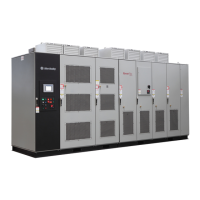36 Rockwell Automation Publication 6000-TD004D-EN-P - November 2017
Chapter 1 Functional Descriptions
The frequency compensation feature should be enabled if static fly start is
required to prevent “output short circuit” fault from occurring. The value of
Flying Start Compensation Frequency Reduce Speed should not be set too small,
especially if there is a large amount of inertia present. The default value is
sufficient for general purpose applications.
Use the third flying start mode, “search frequency from maximum frequency” to
implement AC mode to VF mode.
Load Loss Control
This function is used to avoid motor regeneration. In normal operation, there
will be a quick acceleration of motor speed when there is a sudden loss or heavy
reduction of load. At this time, the motor works in regeneration mode and the
DC bus of the power cell is charging which will lead to power cell over voltage.
The following parameters are used for this function:
• Load Loss Control Enable (P045)
• Load Loss Enable Frequency (P046)
• Load Loss Control Differential Scaling (P047)
• Load Loss Frequency Compensation Upper Limit (P048)
• Load Loss Control Scaling Factor (P049)
• Load Loss Control Integral Time (P050)
• Load Loss Control Filter Time (P051)
• Load Loss Enable Current Threshold (P052)
• Load Loss Control Exit Delay (P053)
Motor Auto-tune
This function is used to measure the motor parameters and it can calculate the
values automatically or by nameplate. The motor parameters can be set manually
but it is recommended to set them automatically to ensure system performance.
The motor parameters include motor stator, motor rotor, and motor magnetizing
current.
The following parameters are used for this function:
• Motor Autotune Selection (P121)
• Motor Autotune Delay (P122)
• Motor Autotune Filter Time (P123)
• Motor Autotune Current Id Kp (P124)
• Motor Autotune Current Id Ki (P125)
• Motor Autotune Current Iq Kp (P126)
• Motor Autotune Current Iq Ki (P127)
• Motor Autotune Id Feedback Error Valid (P128)

